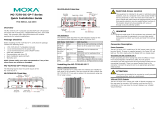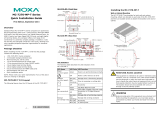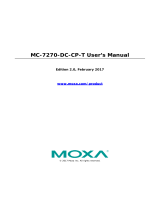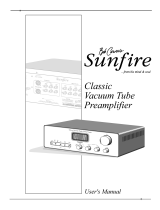B&K series II User manual
- Category
- Audio amplifiers
- Type
- User manual
This manual is also suitable for

Reference 7270
series II
Seven Channel Amplifier
OWNER’S MANUAL
B & K Components Ltd.
P/N 13009 Rev.0102

B&K Components, Ltd 2100 Old Union Road Buffalo, New York 14227
P/N 13009 Rev.0102

TABLE OF CONTENTS
Safety Precautions page 2
Purpose and function page 3
Design and construction page 3
Features page 3
Rear panel view page 4
Rear panel description page 4
Level controls page 5
Inputs page 5 - 6
Outputs page 6
System installation page 7
Making the connection page 8
Control Muting page 9
Troubleshooting page 10
Care and cleaning page 10
Specifications page 11
Warranty page 12
Accessories included: Manual and Power cord
Page 1
P/N 13009 Rev.0102

SAFETY PRECAUTIONS
PLEASE READ BEFORE INSTALLING
WARNING: TO PREVENT FIRE OR SHOCK HAZARD, DO NOT EXPOSE THIS UNIT
TO RAIN OR MOISTURE.
The lightning flash with an arrowhead, within an equilateral triangle, is intended to
alert the user of the presence of uninsulated “dangerous voltage
” within the
product’s enclosure that may be of a sufficient magnitude to constitute a risk of
electric shock to you.
The exclamation point within an equilateral triangle is intended to alert the user of
the presence of important operating and maintenance (servicing) instructions in
the literature accompanying the unit.
y Observance of polarity is essential. Double-check connections before turning the
amplifier on. The amplifier can be damaged if the unit is connected when its polarities
are incorrect.
y Damage can occur to your speakers if the power rating* of each individual driver is
exceeded by the amplifier. Make sure that all the drivers in your speaker system are
capable of handling not only the continuous power being delivered by the amplifier,
but the energy that is likely to be generated during strong and dynamic passages.
y Turn the amplifier ‘off’ before plugging in or unplugging the input and speaker
cables!!!
y The Reference 7270 series II is equipped with raised feet so that continuous
ventilation can be maintained. They also help to keep acoustic feedback into the
amplifier at a minimum. Additionally they provide a measure of protection against
scratching any surface the unit might be resting on. Do not alter or remove them.
y Do not stack anything on top of the amplifier (preamplifier, processor, source, etc.).
y Leave at least 2-3 inches clearance from the top of the amplifier to the next shelf,
component, etc., to insure proper ventilation.
* If you are at all unsure of what the speaker ‘ratin
g
s’ are, contact your dealer.
Page 2
P/N 13009 Rev.0102

THE REFERENCE 7270 SERIES II PURPOSE AND FUNCTION
The Reference 7270 series II is a high current, seven channel power amplifier. It is
designed to be used in all types of audio or audio/video systems.
DESIGN AND CONSTRUCTION
The Reference 7270 series II utilizes high quality electronic circuitry to achieve an
environment wherein a detailed, transparent, and highly musical sound can be realized.
The high quality parts complement includes; state-of-the-art solid state devices, 1% metal
film resistors, computer grade electrolytic power supply capacitors, and a high capacity
toroidal transformer.
The Reference 7270 series II operates with a class A predriver and AB high current
MOSFET power output stages. It is capable of reproducing the most demanding audio
signals at its rated power levels.
FEATURES
THX Ultra Certified
- The unit has passed a rigorous series of Lucasfilm THX quality and
performance tests and it is guaranteed that this amplifier will give superb performance for
years to come.
Toroidal Transformer
- Efficient, high current, shielded transformer that supplies the
amplifer with a clean and constant supply of power, even during highly demanding
source material passages.
Discrete Circuitry
- Dynamically provides a full, accurate, and three dimensional
reproduction of source material.
Class A Predriver
- Improves low level detail and clarity for smoother, more musical
sound.
AB MOSFET Output Stage
- Provides efficient and linear power delivery, as well as
protection from thermal overload.
Gold Plated Connectors
- Improved connections for better sound quality and minimized
signal loss and degradation.
1% Metal Film Resistors
- Higher quality resistors for lower noise, better sound, and a
greater degree of repeatability.
High Current
- Ability to cleanly, accurately, and reliably reproduce demanding
recordings or source materials into low impedance drivers and speaker systems.
Computer Grade Capacitors
- Large capacity computer grade electrolytic capacitors for
extended low frequency control, increased power supply, and improved dynamics.
Fused Outputs
-
Provides limited protection from accidental shorting of amplifier outputs.
Heavy Duty Gold Binding Posts
- Improved current carrying capacity and sound quality
Page 3
P/N 13009 Rev.0102

Rear Panel View
1. AC fuse holder 4. Amplifier control muting input/output
2. AC Input receptacle 5. Level controls
3. Speaker outputs 6. Inputs
7. Speaker fuses
REAR PANEL DESCRIPTION
1. AC fuse holder
- Holds the AC Line fuse. This fuse is a 15 Amp / 250 Volt Slow Blow
fuse. Replace only with the same type and value fuse.
2. AC Input receptacle
- For attaching the supplied AC power cord to the amplifier.
3. Speaker outputs
- For connecting the speakers to the amplifier. Explained further on
page
6.
4. Amplifier control muting input/output
-
To provide remote switching of the mute
on/off feature of the amplifier. Explained further on pages
(8 - 9).
5. Level controls
-
For adjusting the input level of each channel into the amplifier. There
are seven level controls on the back of the amplifier. One level control for each channel.
6. Inputs
- For connecting signal patch cables (interconnects) from the preamplifier to the
amplifier to pass a signal. Pages (5 - 6).
7. Speaker Fuses
- Protection against amplifier damage in the case of shorted speaker
wires. Replace fuse with the same value 6 AMP T-Lag only!
VERY IMPORTANT!
Page 4
P/N 13009 Rev.0102
4
6
7
5
3
2
1

LEVEL CONTROLS
THX certified units are denoted by the THX Ultra logo on the faceplate of
the unit. For use in THX reference theater system, the level controls must
be set to the full clockwise position (highest possible level).
Generally in a home theater application, the level controls on the rear will not be used. All
of the levels will be matched through the surround processor. In a system that uses the
Reference 7270 series II for other applications, adjustment of level controls may be
needed. Start with the level controls turned all the way up (fully clockwise), then adjust
the level according to your system requirements to match each speaker as to produce
the same sound pressure level with the same reference input.
When using a combination of different speakers that may have different speaker ratings
and efficiencies, the level controls may be used to match the output level of the speakers
in the system. Example: Using a speaker with an efficiency of 93 dB @ 1w/1m and a
speaker with an effiency of 97 dB @ 1w/1m together. A 97dB speaker may sound louder
than a 93 dB speaker at a given volume level. The level control for a 93 dB speaker
would be set at a relative level that is higher than a 97 dB speaker to match their audio
volume levels. Turning the level control knob clockwise will increase the relative output
volume of the speaker. Turning the level control knob counter clockwise will decrease the
relative output volume of the speaker.
INPUTS
RCA type connectors accept line inputs from the preamplifier’s output connectors. There
are seven input connectors, one for each channel, that may be used to connect the
amplifier to the preamplifier.
RCA cable connector
Page 5
P/N 13009 Rev.0102
08/&$6),/

Here is a typical preamplifier to amplifier setup:
OUTPUTS
Five way binding posts are provided. There is one pair provided for each channel. They
are designed to accept a banana-type plug, spade-lug connector (shown below), terminal
posts, and bare wire, and they are color coded for easy identification. The positive (+)
post should always be connected to the speakers (+) jack. The negative (-) post should
always be connected to the speakers (-) jack.
Spade connector Banana jack
Here is a typical amplifier output setup:
Page 6
P/N 13009 Rev.0102
R
From Front
Right Output
From Front
Left Output
L
SR
From Rear
Right Output
SL
From Rear
Left Output
C
From Center
Output
From Surr
Back Right
Output
SBL
SBL
From Surr
Back Left
Output

SYSTEM INSTALLATION
There will most likely be a number of cables involved in the installation of your home
entertainment system. Preplanning is essential in order to maximize system efficiency.
We recommend the following as a means of helping you reach that goal:
Make a diagram of your proposed system by laying out the relative location of each
component in the system. Then lay out the proposed cable runs between them.
Number each cable and record its length on the diagram for future reference.
Cable runs are critical in that they must be kept away from sources of power radiation
(amplifiers, power cords, heaters, appliances, etc). For safety reasons, they should
also be kept out of traffic areas.
The process of optimizing the system will include the type of cable, the length of the
run, and the obstructions it must deal with along its run. Your dealer can advise you
on the products available and their relative merits. If building custom length audio
cables is not your strength, your dealer should be able to help you with that as well.
When possible, use a separate AC power line for the amplifier, one that is not shared
by any other household component.
THIS IS VERY IMPORTANT!!!
Tip: Take a piece of strin
g
(lon
g
er than the lon
g
est cable run) and mark it at each foot of len
g
th. Then do a
mock cable run usin
g
the strin
g
, dressin
g
it neatly alon
g
the way. Count the divisions to the next full foot,
and add one foot to allow for some movement of the components. This will provide you with the ideal cable
len
g
th.
Page 7
P/N 13009 Rev.0102

MAKING THE CONNECTION
Before doing anything, insure that the power switch on the amplifier’s front panel is in
the ‘off’ position.
Again, it is recommended that you locate a separate AC power outlet for the amplifier,
one that is
not
shared by any other audio component in the system or any other
household component. This will eliminate the possibility of the amplifier ‘modulating’
the power being supplied to the component and compromising the signal originating
from that component.
Locate the AC power cord provided with the amplifier and plug it into the power input
receptacle in the rear panel.
Do not connect it to the AC power source yet!
Connect the audio cables from your preamplifier’s output to the corresponding input
connector on the amplifier.
Connect the wires from your speakers to the appropriate outputs on the amplifier. It is
absolutely essential that you observe correct polarity in all of these connections.
Example:
If you connect your left front output of your preamplifier to channel 4 input on the amplifier,
remember to connect your left front speaker wires to channel 4's outputs. Always observe polarity when
connectin
g
speakers, connect amplifiers (+) to the speakers (+) and amplifiers (-) to speakers (-).
Double check all connections.
Connect a playback unit (CD, DVD, VLD, Tuner, etc.) to the preamplifier. Turn on the
preamplifier, turn the volume on the preamplifier to a minimum level, then turn on the
amplifier (in that order). Set the source on the preamplifier to the playback unit you’ve
just connected. Turn the volume up slowly and listen for music from all channels. If
this is not the case, and you don’t hear any sound, double check your installation.
Should you encounter any problems that cannot be traced to the source or the
material being played, consult the “TROUBLESHOOTING” section on page 10.
Note: When turnin
g
equipment ‘off’, the amplifier should always be turned off
first
, then
the preamplifier. When turnin
g
equipment ‘on’, the preamplifier should always be turned
on
first
, then the amplifier.
Before turnin
g
anythin
g
on, insure the preamplifier is at a
low volume level.
Page 8
P/N 13009 Rev.0102

CONTROL MUTING
A control is used to “trigger” various outboard amplifiers, projectors, or other accessories
by sending a specified voltage when a certain mode or source is selected from the
source of the control voltage “trigger”. A control system is provided on each Reference
7270 series II amplifier to allow remote switching of the mute on/off feature. A
preamplifier’s control output, such as what is provided with B&K series preamplifiers, can
be utilized to provide a control signal to the Reference 7270 series II. If more than one
amplifier is being controlled, the control signal can be extended to include each
successive unit by simply running a 1/8" MINI - JACK cable from the CTRL OUT
connector of the first amplifier to the CTRL IN connector of the next unit (commonly
referred to as ‘daisy chaining’). An example of how to connect two amplifiers is illustrated
in Figure E below.
If a source other than a B&K series preamplifier is used to control one or multiple
amplifiers, only the control output voltage from the source is critical. It must be within the
range, as indicated on the rear panel, of 5-24 volts AC or DC. The amplifier will provide
each successive amplifier with a control voltage of 12 volts DC for reliable operation. The
amplifiers control output may be used as a source of 12 VDC @ 125 mA for other user
applications as well.
DO NOT POWER MOTORS WITH THIS CIRCUIT!!!
If the control function is desired, each unit in the system must remain connected at all
times and the control must be enabled. To enable the control function, the CTRL IN jack
must have a 3.5mm mini jack plugged into it for each controllable amplifier in the system.
* Note: The control voltage is for muting control only. Each amplifier must be connected
to its own source of AC power in order for it to operate.
Page 9
P/N 13009 Rev.0102
Rear view of second
amplifier with control input
Rear view of amplifier
with control input
Daisy chain to
other amplifiers
From preamplifier
rear panel
control output

TROUBLESHOOTING
1. Replace blown rail fuse inside
amplifier
1. Blown rail fuseChannel sounds distorted
and low in output
1. Check all connectors and repair
as necessary.
1. Poor
g
round connection in inter-
connect cables.
Loud hum or buzz on one
or more channels
1. Check connections makin
g
sure
that cables are connected (+)
to (+) and (-) to (-)
1. Speakers connected out of
phase
Sound lacks direction,
bass weak
1. Ti
g
hten, repair or replace cable
2. Ti
g
hten, repair or replace cable
3. Ti
g
hten, repair or replace cable
4. Check all switch settin
g
s
5. Check all speaker fuses
6. Re-adjust level controls
1. Speaker leads loose or faulty.
2. Line sta
g
e to amp cables loose
or faulty.
3. Source to line sta
g
e cables
loose or faulty.
4. Line sta
g
e or source not
correctly selected.
5. Speaker fuse blown
6. Level controls adjusted
improperly
No sound on some or all
selected channels (‘on’
LED illuminated
1. Reconnect power cord
2. Check AC switch or fuse
3. Check for shorts or
overloadin
g
4. Supply Control IN with a 5-24 Volt
supply. (Pa
g
e 5)
1. Power cord not plu
gg
ed in
2. Power off at AC source
3. AC power inlet fuse blown or
faulty
4. Control Input not activated.
No sound
(‘on’ LED not illuminated)
POSSIBLE SOLUTIONPOSSIBLE CAUSEPROBLEM
** Note
:
If the unit continues to blow power inlet fuses,
DO NOT USE A
HEAVIER FUSE!!
,
have it serviced
.
CARE AND CLEANING
Under normal use, the amplifier will not require any special care. Over time you may wish
to clean the exterior of the unit by wiping it with a damp cloth to remove any dirt or dust
that accumulates on it. Unplug the amplifier and be sure that it has completely powered
down before you apply any damp cloth. Do not let any liquid enter the amplifier through
the vents in the top cover.
REMEMBER, LIQUIDS CONDUCT ELECTRICITY!!!
You may
clean the connectors on the back panel with isopropyl alcohol annually.
Page 10
P/N 13009 Rev.0102

REFERENCE 7270 SERIES II SPECIFICATIONS
Power rating: 8 ohms 200 watts @ 1 kHz
4 ohms 375 watts @ 1 kHz
Frequency response 5 Hz - 45 kHz
Input sensitivity 1.4 Volts
THD (S+N) 0.09 % @ 1 kHz
Input impedance 33.2 k ohms
Damping factor 450
Current (peak to peak) 75 Amps
Slew rate 14 V / µsec
Dynamic headroom 1.2 dB
S/N (A-weighted) 95 dB
Voltage gain 28
Line voltage 120/220/240 VAC switchable
Dimensions (O.A.) 17"(w) X 19.25"(d) X 7.25"(h)
Weight 78 lbs. max.
Power consumption 1830 watts max
17.5 Amps max current draw
130 watts @ no input
Replacement fuses Line -15 Amp/250 Volt Slow Blow
Rails - 6 Amp/250 Volt T-Lag
Speaker - 6 Amp/250 Volt T-Lag
In-rush - 2 Amp/250 Volt Slow Blow
Control - 0.5 Amp/250 Volt Fast Blow
Page 11
P/N 13009 Rev.0102

LIMITED WARRANTY
B&K Components Ltd., referred to herein as B&K, warrants your B&K equipment a
g
ainst all defects in
material and workmanship for a period of five years from the date of purchase. This warranty applies only to
the ori
g
inal purchaser and only to equipment in normal residential use and service. Defective equipment
must be returned to B&K, prepaid, accompanied by sufficient payment to cover the cost of return shippin
g
and handlin
g
, and will be repaired or replaced at the discretion of B&K whose decision as to the method of
reparation will be final.
This warranty shall not apply to any equipment which is found to have been improperly installed, incorrectly
fused, misused, abused, or subjected to harmful elements, used in any way not in accordance with
instructions supplied with the unit, or to have been modified, repaired or altered in any way without the
expressed, written consent of B&K. This warranty does not apply to the cabinet, the remote controller, or
appearance items such as the faceplate, control buttons, or display lenses, nor does it cover any expenses
incurred in shippin
g
the unit to and from the manufacturer’s service depot.
No warranty, implied or otherwise created by State law shall extend beyond the terms of this warranty and
B&K shall not be liable for any incidental or consequential dama
g
e arisin
g
out of a defect in material or
workmanship of the unit durin
g
the terms of this warranty or thereafter. Some States do not allow the
exclusion or limitation of incidental or consequential dama
g
es and the fore
g
oin
g
exclusions may not apply
to you.
This warranty
g
ives you specific le
g
al ri
g
hts. Your may also have other ri
g
hts which vary from State to
State.
No a
g
ent, representative, dealer or employee of B&K has the authority to increase or alter the obli
g
ations or
terms of this warranty.
B&K Components Ltd.
RETURNING EQUIPMENT
No equipment may be returned to B&K Components Ltd. Without a RETURN AUTHORIZATION. Should
you find it necessary to return equipment to B&K, for any reason, a RETURN AUTHORIZATION (RA)
number must be issued by B&K in respect of the equipment bein
g
returned. You may request an RA
number by callin
g
B&K at the numbers below. We ask that you provide the followin
g
information at that
time.
1.Your name, address, and phone number.
2.The model and serial number of the equipment bein
g
returned.
3.A description of the problem bein
g
experienced.
Your call will be referred to a Technical Service Representative who will work with you to resolve the
problem. If it is determined that the unit must be returned for repair, an RA number will be issued.
B&K Components Ltd. 2100 Old Union Road, Buffalo New York 14227
1-800-543-5252 or 1-716-656-0023
Page 12
P/N 13009 Rev.0102

B&K Components, Ltd 2100 Old Union Road Buffalo, New York 14227
P/N 13009 Rev.0102

B&K Components, Ltd.
2100 Old Union Road
Buffalo, New York 14227
www.bkcomp.com
P/N
1
300
9
Rev.
0
102
-
 1
1
-
 2
2
-
 3
3
-
 4
4
-
 5
5
-
 6
6
-
 7
7
-
 8
8
-
 9
9
-
 10
10
-
 11
11
-
 12
12
-
 13
13
-
 14
14
-
 15
15
-
 16
16
B&K series II User manual
- Category
- Audio amplifiers
- Type
- User manual
- This manual is also suitable for
Ask a question and I''ll find the answer in the document
Finding information in a document is now easier with AI
Related papers
Other documents
-
 Moxa Technologies MC-7200-DC-CP-T Series Quick Install Guide
Moxa Technologies MC-7200-DC-CP-T Series Quick Install Guide
-
 Moxa Technologies MC-7270-MP-T Quick Install Guide
Moxa Technologies MC-7270-MP-T Quick Install Guide
-
 Moxa Technologies MC-7200-DC-CP-T Series User manual
Moxa Technologies MC-7200-DC-CP-T Series User manual
-
Moxa MC-7200-MP-T Series User manual
-
Burster 7270 Owner's manual
-
Parat PARASYNC for iPad 2 User manual
-
McIntosh MC2000 Owner's manual
-
NAD S170 User manual
-
 Sunfire Classic Vacuum Tube Control Center User manual
Sunfire Classic Vacuum Tube Control Center User manual
-
Genesis Monitor 2 User manual



















